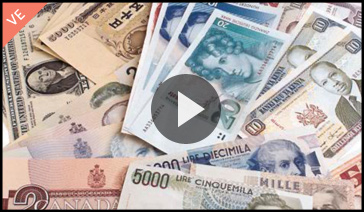
Grades 9-12
Happy EconEdMonth! Celebrate economics all month long by visiting EconEdMonth.org

Don't have an account yet? Sign up for free
Don't have an account yet? Sign up for free

Students describe and identify where certain items they own come from and the approximate price of these items. They learn that to purchase an imported item they have to pay the people from whom they bought the item in their country’s currency. Moreover, if they want to travel to another country, they have to pay for the goods and services they buy in that country’s currency. Students calculate foreign exchange rates and derive an equation to convert prices for goods in one country’s currency compared with another.
The student will be able to:
When purchasing goods and services from or in a foreign country, people typically must pay in that country’s currency. To do that, people exchange one currency for another at a specific exchange rate. Exchange rates are determined in foreign exchange markets where individuals, firms, and countries around the world can buy and sell currency. The interactions of these buyers and sellers (or more specifically the demand for and supply of a currency) determine the value of a particular currency compared with another.
The fluctuations in exchange rates play a key role in determining the purchasing power of individuals, such as tourists in a foreign country. An increase in the value of a currency is good news for importers; they can buy more goods for a dollar. However, that same change is bad news for exporters; their goods are now more expensive for foreigners to buy. A decrease in the value of a currency is bad news for importers; they can buy fewer goods for a dollar. However, that same change is good news for exporters; their goods are now less expensive for foreigners to buy.
Understanding how to calculate exchange rates and analyze the effects of an appreciating or depreciating currency increases awareness regarding the price of goods and services.
|
January (Cost in USD) |
March (Cost in USD) |
|
| 1. A hamburger combo meal in Mexico = 67.00 Pesos |
$5.20 |
$4.00 |
| 2. A hamburger combo meal in Thailand = 165.97 Bhat |
$5.16 |
$5.18 |
| 3. A hamburger combo meal in Japan = 535.53 Yen |
$5.18 |
$4.60 |
| 4. A hamburger combo meal in Canada = 5.50 Canadian Dollars |
$5.24 |
$5.67 |
|
Appreciated |
Depreciated |
|
| Mexican Peso |
X |
|
| Thai Bhat |
|
X |
| Japanese Yen |
X |
|
| Canadian Dollar |
|
X |
Multiple Choice
Short Answer
Sony is exporting its newest gaming system to the US. The system costs 40,800 yen in Japan. If the dollar is valued as 102 yen, what is the price of the system in US dollars? Show your work.
[40,800/102 = $400]
GM produces and sells a compact car for $26,000. Volkswagen produces and sells a compact car for 19,000 euros. If the exchange rate is 1 dollar for 0.72 euros, which car would be the least expensive choice? Show your work.
[The GM car would be cheaper—18,720 euros versus 19,000 euros for the Volkswagen.
26,000 X .72]
[The GM car would be cheaper—$26,000 versus $26,389 for the Volkswagen
19,000/.72]

Grades 9-12

Grades 6-8, 9-12

Grades 6-8, 9-12

Grades 3-5, 6-8, 9-12
